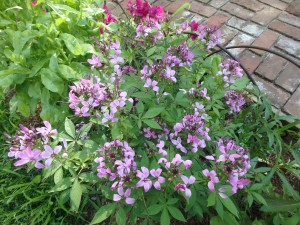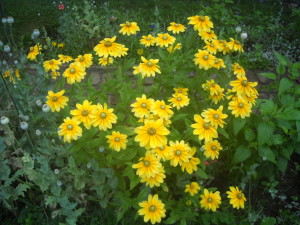Mid-Summer Blues … and Reds and Yellows
It’s been a hot dry summer and many gardeners are lamenting the lack of color in their flower gardens. While it’s true that this is a quiet period for many perennials, there are plenty of flowers that are blooming – and plenty more on the way. Let’s take a look.
First, there are the annuals. Annuals are flowers that only get one chance to continue their genetic line. If they don’t make seeds and get them in the ground, they will die out. Of course, those silly flowers don’t realize that all the big seed companies have plenty more seeds with similar or identical genetic material, and will be selling seeds for flowers just like them next year. But, not knowing that, annuals keep on blooming in hopes of perpetuating their genetic line.
Some annuals need to be dead-headed in order to keep blooming. We have to play the role of the deer or woodchuck or cow that might nip off the blossoms, signaling a need to produce more flowers and eventually seeds. If you don’t cut off the spent blossoms, the flowers will think they have down their job.
Annuals that need to be deadheaded include, but are not limited to the following: bachelor buttons, cosmos, gaura, gazanias, geraniums, marigolds, osteospurmum, pansies of all types, pincushion flower, salvias, snapdragons, sunflowers, verbenas and zinnias. Some of those, like marigolds and zinnias will bloom for long periods of time even if you don’t cut off the spent flowers. Many will branch and produce greater numbers of flowers after deadheading – cut off one snapdragon stem, get six more, for example.
Other annuals have been bred so that they are “self-cleaning.” That means that spent blossoms fall off and are replaced by new ones. Most impatiens are like that, along with some petunias. I have one petunia called ‘Night Sky’ from Burpee that has been blooming constantly since early June and all I have ever done is water it occasionally. What else? Angelonia, Supertunias, Superbenas, Million Bells (Calibrachoa), portulaca, dragon wing begonias, lantana, nemesia, torenia and oxalis.
Two of my favorite self-cleaning annuals are trademarked varieties (Proven Winners) and are not available in six-packs or by seed, only in pricier 4-inch pots. But they are worth it. First is ‘Senorita Rosalita’ cleome. Unlike the generic cleome, it has no spiky thorn-like appendages and no cat-pee odor. It is a multi-stemmed beauty about 24 to 36 inches tall with 4-inch wide clusters of frilly pink flowers. A knockout. Another is a euphorbia called ‘Diamond Frost’. This has a mass of tiny white flowers, a bit like baby’s breath, that keeps blooming forever. I have grown it in pots and brought them inside for the winter, and it keeps on blooming! Fabulous.
Then there are the perennials. Yes, June has passed and the peonies and primroses and iris have all finished blooming. But there are nice things now: purple cone flowers, black-eyed Susans, phlox and cardinal flowers are all blooming for me now. They are easy, sun-loving flowers that do well in a vase, too.
A few words of advice about the perennials above: in general, the old standards fare better than many of the “new, improved” varieties. And I say that not as an old curmudgeon who doesn’t like change, but as one who has tested many kinds.
So, for example, I have planted hybrid cardinal flower (Lobelia cardinalis), only to have them die after the first winter – even when the pure species plants I had did not. That said, I‘ve had even my best cardinal flower plants die out after a few years. It is not a long-lived plant. It needs moist soil – it is found along the banks of the Connecticut River and I saw a huge patch alongside an abandoned beaver dam this week.
Similarly, I’ve had much better luck with standard varieties of purple cone flower (Echinacea purpurea) than the new hybrid colors such as peach, or yellow. I’ll stick with the old-fashioned pinky-purple ones, thank you very much.
Phlox is an old-fashioned plant, but many of the new named cultivars really are better. They’ve been bred to resist mildew, which makes so many of the old varieties ugly with spotted brown leaves. ‘David’ is a white one that I grow that is very nice.
I love a black-eyed Susan called ‘Prairie Sun’. It rarely over-winters for me, but I accept that flaw because it blooms profusely from July until October. I generally purchase some every year. It is not a hybrid, so sometimes the plants will self-sow, providing free plants. Right now mine are gorgeous.
In order to have blooms all the time – which I do from March to November – you have to keep on buying plants, trying plants, replacing plants. There is no “quick fix.” So visit your gardencenter and ask what they have to brighten up your garden now.
Read Henry’s blog twice weekly at https://dailyuv.com/




